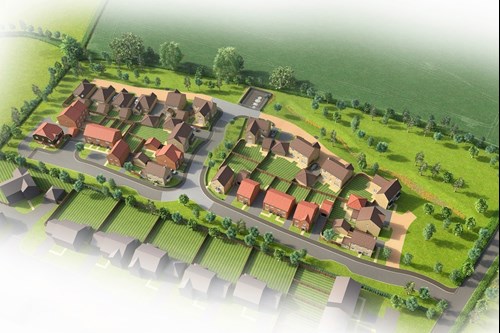Find your new home...
Main menu
Building faster and more sustainable homes at Cala’s first wholly timber frame development in England
Overview
The 28 new homes in Alderton, Gloucestershire will be Cala's first development built using wholly timber frame in England – a construction method that is already being used on around 40 per cent of the homes Cala builds each year in Scotland. The site on Willow Bank Road, in Alderton, marks an important step forward for Cala in its journey towards building homes that are operationally net zero carbon from 2030.
Within a mix of 28 two- to four-bedroom bungalows, maisonettes, and larger family homes, 11 will be provided as affordable housing, comprising both rented and shared ownership tenure. The scheme extends Alder Green, Cala’s first phase of development at the site completed in 2017 and has been designed to respect the rural setting of Alderton with generous landscaping, enabling views of the surrounding countryside. Cala will also contribute funds for off-site play facilities, libraries, and recycling – to be delivered by Tewkesbury Borough and Gloucestershire County councils.
The opportunity
Following a successful partnership with Greystoke Land working through a planning appeal, it was demonstrated that the development would provide a great opportunity to contribute towards local housing need.
Additionally, incorporating carbon reduction measures into the construction of new buildings is one of the priority actions set out in Gloucestershire County Council’s Climate Change Strategy[1]. Following the declaration of the climate emergency, it is aiming to deliver a carbon neutral county by 2045 and will work with partners to deliver an 80% reduction of carbon use by 2030. Cala’s scheme in Alderton supports the council’s mission and will ultimately help it achieve its goal.
Cala’s Sustainability Strategy outlines how the company will achieve the target of building homes which are operationally net zero carbon from 2030. The use of timber frame is a vital part of this journey providing an opportunity to address carbon footprint. The critical benefit of using timber in construction is carbon capture – it has also shown to have up to 20 per cent less embodied carbon than a typical masonry build.
For customers, timber frame could help reduce energy use compared to a traditional masonry structure by offering improved thermal efficiency. This is because the inherent accuracy of factory-produced timber frame can deliver better air tightness than an equivalent masonry build, with a reduction in the amount of natural air leakage and thermal bridging, which can save on the amount of energy used to heat the home.
As well as reducing carbon emissions, timber frame homes have a shorter construction time, reducing the number of hours working on each development – an important consideration on the wider impact of the development on the local environment and neighbouring communities.
However, while over 75% of Scottish homes[2] are built using timber frame, the method, at present, is not widely used in England – currently, only used to build 23% of new homes. The proposed scheme at Alderton provided opportunity to take forward and build a wholly timber frame development.

Our approach
From a design point of view, it was important that the new homes at Alderton were in keeping with the unique character of the Cotswolds. The region is known for the warmth of its stone-walled buildings with prominent chimneys and steep roofs. The development had to capture this character, while being built using timber frame. It meant Cala had to challenge its own methods of construction to complete the scheme using non-traditional material, while still achieving a traditional Cotswolds finish.
It is not just the exterior of the home that timber frame impacts. For example, with much fewer wet materials /trades used, timber framed homes can be wall papered and decorated immediately, whereas masonry homes have to fully dry out over the course of a year, limiting interior décor choices in that period.
In addition, with the majority of the timber frame being CAD designed and manufactured off site, the frames slot together incredibly accurately, meaning less structural movement occurs in timber reducing the likelihood of unsightly cracks within the property.
Cala is passionate about using infrastructure to enable their customers to make positive, sustainability focused changes within their homes. Cala’s customers too are climate conscious with many having expressed their support for the development’s sustainability ambitions during public consultation. Each home at Alderton will have energy efficient underfloor heating, an electric vehicle charging point and will offer high speed broadband connectivity.
Residents at Alderton will also enjoy additional green, public open space along Willow Bank Road, which creates an attractive green gateway to the development and into the village. Cala will also create a landscape buffer along the southern edge to allow space for SUDs land, as well as an enhanced space for local biodiversity achieved by new hedgerows, hedgehog highways and extensive planting of trees and plants.
Where are we now?
Cala has ambitious plans to roll out timber frame construction across the rest of the business with all new Cala sites from January 2024 built using timber frame - except for high-rise buildings or where this is unable to happen due to technical reasons or restoration projects. This will mean that a fifth of Cala’s net zero targets will be fulfilled by implementing this construction method.